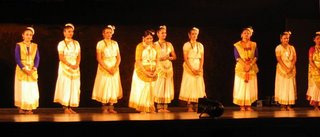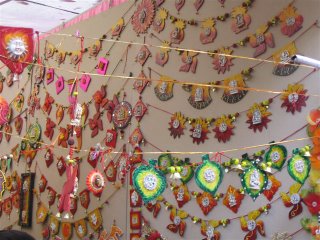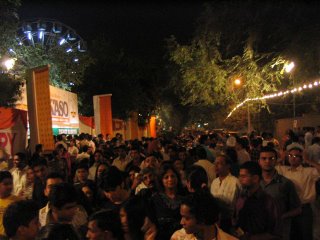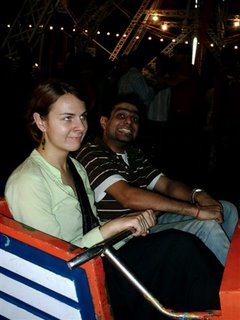Poonam’s place is one of the greatest houses I have ever been too. Its greatness is in the feeling of completeness that saturates each and every part of the house - being it an interior detail or the people inhabiting it. Here comes the perfect understanding of Russian concept - “house like a full cup” (they live in plenty) – that signifies harmony and happiness in the physical habitat and emotional relationships in the family. In the “house like a full cup” you can sense the peaceful co-existence and self-sufficiency of the people living there and they space they altogether create and use.
On the first place, the notion of a separate house makes the difference on its own right. A house with a small garden and a cozy door-yard, creates the feeling of space and independence that is unthinkable for an apartment in a block of flats where your habitat is limited by the ceiling, floor and walls of your neighbors from all sides. Moreover, a house that you can just walk in from the ground floor looks incredibly open, hospitable and relaxed.
A fairly spacious living room welcomes you once you enter Poonam’s house: the room is organized in concentric rectangles – the outer frame is made up by the cupboards hosting souvenirs, crafts, photographs, vases; the mid rectangular is organized with sofas and chairs that are set along the sides of the beautiful carpet, the inner rectangular in the middle of the room. A transparent curtain separates this room from the other living room, a smaller one with the intimate atmosphere created by the soft lights and small sofas cozily set around the small table. That room further flows into dining room and open-plan kitchen and leads to the bedrooms, bathrooms and other-purpose rooms. The very number of rooms in the house creates the notion of abundance - abundance of space for each and every family member and any guests happened to drop by, abundance of ideas as each room is finished in its distinctive style and abundance of stories that the house has got to tell. The decorations – vases, lights, candles, paintings, pictures, statues, souvenirs - brought from all over by the family members or gifted by the friends – silently speak volumes about the family. They shows the long history that the family has got, show how firm the family bonds are if they have been maintained for so long, show how the family is connected to the outside world, how it explores around and show the efforts invested in creating and nurturing its space, its home - shelter or fortress or open house depending on the occasion….
How, how, how – to create such an atmosphere and to maintain it? Every time I come to this house I find a few bouquets of fresh flowers decorating the rooms. The flowers look like a sign of continuous care over the house that is meant to look beautiful and welcoming.
How come you’ve got so many fresh flowers in the house? – I asked once.
I just got them this morning, - she explained.
Indeed, as easy as that: if you want your house to look taken care of - take good care of it. Indeed, Poonam as may other women in India resorts to the services of various domestic helpers (gardener, sweeper, cleaner, cook etc) yet it comes down to her agency as for whether, what and how. Everything in the house is under her deliberate supervision and the caring eye.
Poonam would always be an exemplary of an excellent host for me. She invites you to come over whenever she sees you and she means it. She gives you space yet makes sure you are provided with anything needed.
“Hi Olga!” – after hugs and kisses and taking seats the questions comes “What drink can I offer you? Vodka-juice, rum-coke? Baccardi-lemonade?” – she smiles perfectly remembering that last time I opted for the latter. Everything in the house follows the routine yet without any sign of being imposed. Poonam opens her impressive bar and keeps fixing the drinks throughout the night. She makes sure the conversations flow, empty glasses get refilled and snacks get passed around. She feeds the conversations with her stories: oh, she can knowledgeably talk about any topic and would definitely have a point of view to present.
On Diwali she suggested we follow the tradition and play cards to welcome prosperity in the new year. She was encouraging and maintaining the spirit of everyone and made sure everyone was involved. When discussing how high the stakes we should go for and when her father-in-law said, “1 rupee a bill”, she played up “Papa, at least 2 rupees” not for the sake of the deal but to raise the competitive spirit - it is clear from the beginning no money would be involved. She explained the rules, we played an open round and only when everyone understood the rules we could start. It is the rule of thumb in this house – no one can be left out. Poonam was passing comments on the course of the game – teasing gamblers, cheering unlucky fellows, praising the winners and jokingly bluffing herself. “Lovely!”- and she applauses. “What a game!” and she discusses the combinations that just won.
The conversation and the game are followed by the meal with explanations about the preparation tricks and cooking as such. After that sweets are served and accompanied with discussions of dining out places and cuisines of various parts of India. Then we move back to the big living room where coffee and liquors - the ultimate luxury to indulge – are served to round up the evening.
Poonam exactly knows how to treat her guests. I wonder if there is any situation she would not know how to go about. And what is more important - she is true to herself and the same irrespective to the people around – the ones she’s known for ages or for just a few days – her maid, in-laws, daughters, dog, adopted Kate, Kate’s parents and orphaned me.
Poonam and Lalit have 2 beautiful daughters, Meghna and Sanjana and a cute fluffy dog Pixi – all those people and creatures comprise the family and its space. Lalit is a captain of a merchant ship and at least half a year he is away. But even when he is not at home he manages to make his presence and care felt. Understandably, it costs tears and many painful moments for the family not to have him and his support around. Yet, gestures like a gorgeous bouquet of red roses and cake he sent to his wife and daughters for Diwali and his calls when the phone is passed from one person to another still make it complete.
…..
Every time I leave Poonam’s house as much inspired as melancholic. I get ultimately convinced that only having a family makes one’s life complete and the ability to set up and nurish one is the only true check of your worth…


























